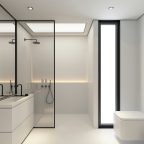
How to Create a Warm and Welcoming Entrance Hall
The entrance to your home is usually the first thing that anyone will see. It will often set the tone for how the rest of your home feels. If the entrance hall is unwelcoming, gloomy and glum, it can have an impact on how you feel. It can also impact visitors coming into your home, perhaps even making them feel unwelcome. To improve your entrance hall, it is time to commit to making it feel a lot more welcoming and warmer.
Measure the Space You Have to Work With
It helps to know the size of the space you are working with, so take measurements. Measure the length and width of the hallway, and even measure the height. If you have a long and narrow entrance hallway, you may just need to use the height better. When you are measuring the space, always allow for door openings, and make sure you have measured from as low down as possible. When you do this, you allow for skirting boards and other decorative trims in your measurements.
Remember, Functionality is Crucial
After getting your measurements, it is then time to think about functionality. The entrance hall must be a place where coats, bags and shoes can be dumped quickly on a rainy or muddy day. It also must be a place where you can clean up quickly. When it comes to focusing on functionality, you need to think about everything from the furniture you use to the flooring you lay. To keep the dirt at bay, you might wish to visit flooring.uk.com/mats/type/coir-matting to purchase matting to protect floors. You may also wish to have baskets and storage units near the front door that can be used to get dirty or mucky items off the floor.
Focus on the Lighting
Hallways feel much warmer and more welcoming when they are well-lit. Even if a space is flooded with natural light, you will still need to think about ambient lighting for the evening. When it comes to lighting, think about downlighters and recessed lighting. Also, look at incorporating mirrors in small spaces, as these allow the light to bounce off walls and around rooms. Feature or statement lighting such as a bespoke table lamp or a chandelier can draw in the eye and help take away the focus from smaller or narrower spaces.
A Warm Colour Palette is Essential
The colours that you use on the walls and ceiling will make an impact on how the room feels. If you have a low ceiling, you will want to make a room feel higher by painting the ceiling in a light and bright colour. If you use dark colours in small spaces, it will make areas feel claustrophobic, and this is what you want to avoid. Warmer colours such as beige and earthy tones will help make a space feel more expansive than it is. Warmer tones will also make a space feel much cosier and warmer, especially in those colder months.

















